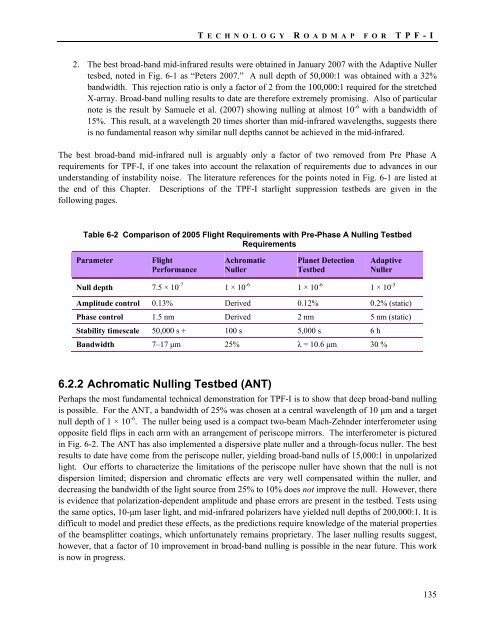TPF-I SWG Report - Exoplanet Exploration Program - NASA
TPF-I SWG Report - Exoplanet Exploration Program - NASA
TPF-I SWG Report - Exoplanet Exploration Program - NASA
Create successful ePaper yourself
Turn your PDF publications into a flip-book with our unique Google optimized e-Paper software.
T E C H N O L O G Y R OADMAP FOR <strong>TPF</strong>-I<br />
2. The best broad-band mid-infrared results were obtained in January 2007 with the Adaptive Nuller<br />
tesbed, noted in Fig. 6-1 as “Peters 2007.” A null depth of 50,000:1 was obtained with a 32%<br />
bandwidth. This rejection ratio is only a factor of 2 from the 100,000:1 required for the stretched<br />
X-array. Broad-band nulling results to date are therefore extremely promising. Also of particular<br />
note is the result by Samuele et al. (2007) showing nulling at almost 10 -6 with a bandwidth of<br />
15%. This result, at a wavelength 20 times shorter than mid-infrared wavelengths, suggests there<br />
is no fundamental reason why similar null depths cannot be achieved in the mid-infrared.<br />
The best broad-band mid-infrared null is arguably only a factor of two removed from Pre Phase A<br />
requirements for <strong>TPF</strong>-I, if one takes into account the relaxation of requirements due to advances in our<br />
understanding of instability noise. The literature references for the points noted in Fig. 6-1 are listed at<br />
the end of this Chapter. Descriptions of the <strong>TPF</strong>-I starlight suppression testbeds are given in the<br />
following pages.<br />
Table 6-2 Comparison of 2005 Flight Requirements with Pre-Phase A Nulling Testbed<br />
Requirements<br />
Parameter<br />
Flight<br />
Performance<br />
Achromatic<br />
Nuller<br />
Planet Detection<br />
Testbed<br />
Adaptive<br />
Nuller<br />
Null depth 7.5 × 10 -7 1 × 10 -6 1 × 10 -6 1 × 10 -5<br />
Amplitude control 0.13% Derived 0.12% 0.2% (static)<br />
Phase control 1.5 nm Derived 2 nm 5 nm (static)<br />
Stability timescale 50,000 s + 100 s 5,000 s 6 h<br />
Bandwidth 7–17 μm 25% λ = 10.6 μm 30 %<br />
6.2.2 Achromatic Nulling Testbed (ANT)<br />
Perhaps the most fundamental technical demonstration for <strong>TPF</strong>-I is to show that deep broad-band nulling<br />
is possible. For the ANT, a bandwidth of 25% was chosen at a central wavelength of 10 μm and a target<br />
null depth of 1 × 10 -6 . The nuller being used is a compact two-beam Mach-Zehnder interferometer using<br />
opposite field flips in each arm with an arrangement of periscope mirrors. The interferometer is pictured<br />
in Fig. 6-2. The ANT has also implemented a dispersive plate nuller and a through-focus nuller. The best<br />
results to date have come from the periscope nuller, yielding broad-band nulls of 15,000:1 in unpolarized<br />
light. Our efforts to characterize the limitations of the periscope nuller have shown that the null is not<br />
dispersion limited; dispersion and chromatic effects are very well compensated within the nuller, and<br />
decreasing the bandwidth of the light source from 25% to 10% does not improve the null. However, there<br />
is evidence that polarization-dependent amplitude and phase errors are present in the testbed. Tests using<br />
the same optics, 10-μm laser light, and mid-infrared polarizers have yielded null depths of 200,000:1. It is<br />
difficult to model and predict these effects, as the predictions require knowledge of the material properties<br />
of the beamsplitter coatings, which unfortunately remains proprietary. The laser nulling results suggest,<br />
however, that a factor of 10 improvement in broad-band nulling is possible in the near future. This work<br />
is now in progress.<br />
135
















